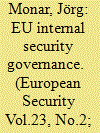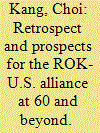| Srl | Item |
| 1 |
ID:
128237


|
|
|
|
|
| Publication |
2014.
|
| Summary/Abstract |
There are clear indicators that in spite of the sensitivity of internal security in terms of essential state functions and national sovereignty an EU governance framework with specific characteristics has emerged in the counter-terrorism field. Common threat assessments guide governance responses, and specific institutional structures, cooperation mechanisms, legal instruments, and forms of external action have been put into place to respond to the cross-border nature of the terrorist challenges. However, in line with the general subsidiary role only of the EU as provider of internal security in addition to the Member States, this governance framework remains based on the interaction and cooperation between national counter-terrorist systems and capabilities that remain largely under national control and still enjoy relatively wide margins of discretion in terms of priorities, legal framework, and organization. This analysis concludes that the EU's internal security governance - as evident from the counter-terrorism field - may be best characterized as an advanced institutionalized system of cooperation and coordination between national governance frameworks constructed around a core of common instruments and procedures with a cross-border reach.
|
|
|
|
|
|
|
|
|
|
|
|
|
|
|
|
| 2 |
ID:
125264


|
|
|
|
|
| Publication |
2013.
|
| Summary/Abstract |
The year 2013 marks the 60th anniversary of the ROK-U.S. alliance. The catchphrase "We go together," which is used in the ROK/U.S. Combined Forces Command (CFC), well captures its founding spirit. Since the beginning of the alliance, with the signing of the ROK-U.S. Mutual Defense Treaty in 1953, it has been a key element in both countries' security strategies. Both have agreed to upgrade the alliance to "strategic alliance." To realize a strategic alliance, clear guidelines that go beyond simple rhetoric must be adopted and an action plan devised through intense discussions. For that purpose, it is essential for South Korea and the United States to undergo a bottom-up review process of the alliance. It is important to pay careful attention to: identification of challenges the two must cope with together (for what); the division of labor (who should do what); plans and strategy (how); and cooperation mechanisms (through what). Along these lines, it is important to think about how to enrich the contents of military cooperation as the backbone of the alliance. To avoid any misunderstanding and over-expectations of the United States, South Korea must make it clear what it can and cannot do on the basis of undiminished mutual respect.
|
|
|
|
|
|
|
|
|
|
|
|
|
|
|
|